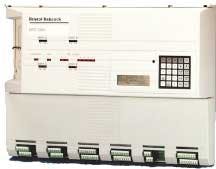By Joe Hastreiter
Operations at the Stanleigh uranium mine in Elliot Lake, Ontario, were closed down in 1996 after some 15 years of extracting fuel for Canadian nuclear power plants. The challenge facing the owners was to decommission the site and address several environmental issues.
One of these issues was maintaining the process of treating the leachate (rainwater and melting snow) that comes in contact with the more than 20 million tons of tailings, or crushed rock, that remained after the uranium ore had been removed.
Art Coggan, Manager of Environment and Reclamation, Rio Algom Limited, said the preferred method of stabilizing tailings in modern technology is "flooding" (keeping tailings submerged). In the case of the Stanleigh mine, the tailings are contained in a rock basin that receives runoff from the natural watershed of rain and melting snow. The result is a 150-acre pond with tailings on the bottom.
As the water comes in contact with the tailings, it picks up minute amounts of heavy metals (copper, nickel, lead), radium, and uranium. To remove these contaminants, an 8,000 gpm effluent treatment plant was built. Only clean water is discharged into nearby McCabe Lake, which abounds with bass, lake trout, and other species.
Protecting the Lake
Although the effluent plant has many fail safe control features to protect the crystal clear lake, the basic treatment is a "fairly simple process," said Coggan. "We adjust the pH of the incoming water, add barium chloride to precipitate radium, add flocculent to enlarge the precipitates, and filter the effluent through sand bed filters."
The filters are batch affairs cycled through a filter cycle followed by a backflush to remove the captured sludge. The sludge is then piped back to the submerged tailings.
To ensure process integrity, the control system designed and installed by Bristol Babcock Canada features two processors - one running on line, and the other in a "hot stand by" mode. Thus, there is no potential for single point failure at the controller level. Orchestrating the treatment operation is a Bristol Babcock Model RSP 3332 controller.
The treatment plant is licensed by the Canadian Nuclear Safety Commission (CNSC) which sets allowable discharge limits for a combined copper, nickel, lead, and zinc level of no more then 1 ppm. The plant's discharge typically ranges between 0.2 and 0.3 ppm.
Ensuring System Reliability
In 2001, the plant was retrofitted with a new Human Machine Interface (HMI) software package that offered better reliability and less chance of system lockup than the PC based software it replaced. Taking responsibility for this upgrade was Donson Engineering, North Bay, Ontario.
This changeover required a total understanding of the control system, including the controller code, said Winston Books, Marketing Manager, Bristol Babcock Canada. "You can't change a single line of code without having an impact on the overall control system."
Kevin Quigley, Vice President, Donson Engineering, noted there is a "tremendous amount of logic" designed into the Bristol Babcock controller that will shut the plant down under numerous conditions. We "pulled our hair out" over the complexity of the logic and the level of control. "But realistically, when you take a step back, all this control is necessary if you want to make sure you do not pollute any lakes," he said.
He noted an overriding concern - the possibility of bad water getting through the plant - could "keep you up at night." Therefore, the system designers had to insure that if a problem did develop the plant would shut down.
In evaluating the controller that the HMI software interfaced with, Quigley said it was put through "hundreds and hundreds of scenarios" to try and make it fail, but the unit held its own. "It was programmed to make sure all the conditions were met," he said.
Among other things the controller maintains the flow at whatever rate is chosen. It controls the lime based on the pH reading, and monitors the head loss on the filters (based on backpressure from the sludge collected in the sand bed). When the reading reaches the level the operator has programmed, that filter is automatically taken off-line, back washed, and another filter is put on line to take its place.
Environmental Control
The environmental benefits of the effluent treatment plant are plain to see, said Quigley. The receiving water body, McCabe Lake, can be characterized as a natural wilderness that you would expect to see in this part of Ontario - towering pines, waterfowl, and crystal clear water.
The effluent treatment facility is fully automated via a radio link, which allows monitoring the plant operation remotely from Rio Algom's Elliot Lake office, six miles away. This link allows operators to make process changes. If a problem does develop, the person on call is contacted and given a verbal message on the pH or TSS (total suspended solids) levels.
If either of the two get out of the programmed range, the computer shuts down the plant, sounds an alarm, phones the operator, and tells him the pH is low or whatever event has taken place.
Low Radiation
Plant Manager Coggan said that radium, one of the decay products of uranium, and more radioactive, is a concern. After being precipitated out with barium chloride, the radium is contained and pumped by pipeline to the middle of the tailings pond, some 40 feet under water.
However, overall the plant personnel deal with very low levels of radiation. Even if someone would walk across the tailings for some 200 hours during a year's time, the radiation dose would roughly be equal to that received in a single chest X-ray, Coggan said.
Broad application language was another factor in selecting the RSP 3332 controller, said Books. The controller employs Advanced Communication and Control Oriented Language (ACCOL).
"Although many look at the RSP 3332 and say it's just a PLC, actually it's much more than that," he said. "In the controls market, PLCs are very strong on discrete control but they are weak on continuous control. This unit has broad capability in both."
He also noted that the controller's dual processor feature is important in the Stanleigh mine installation because it is expected to run for very long periods of time, and requires low maintenance.
Coggan expects the plant to operate about 10 more years. By then, he said, oxidation should have stopped. That's the beauty of the technology of "flooding" tailings, he said. As time passes and as a result of flushing, sediment forms and oxidation slows down.
"The water quality becomes as good as any other lake and no more treatment is required," he said.
Traditionally, oxidation in mine tailings - regardless of the ore - is the villain. Most tailings contain sulfides and when sulfides oxidize, they form dilute sulfuric acid and also dissolve other contaminants, which are then released from the mine tailings. None of these are good for a lake's ecosystem, he said.
About the Author: Joe Hastreiter is a freelance writer based in Kewaunee, WI




